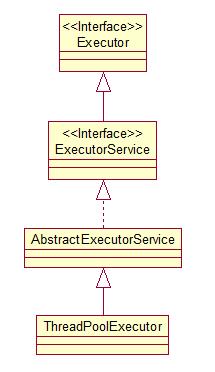线程池ThreadPoolExecutor
Posted tonghun
tags:
篇首语:本文由小常识网(cha138.com)小编为大家整理,主要介绍了线程池ThreadPoolExecutor相关的知识,希望对你有一定的参考价值。
一 概述
1.线程池产生背景
在多线程环境下,频繁地创建与销毁线程会耗费大量的系统资源,降低运行性能,因此产生了一种设计思想:将创建好的线程放到一个容器中,需要时从容器取得线程,使用完毕将线程归还容器,这样就可以重复利用线程,避免了重复创建与销毁造成的资源消耗,提高了性能。
2.什么是线程池?
元素:线程。
本质:容器。
设计目的:使得线程能够被重复使用,降低系统消耗。
一个以多个线程为元素、通过重复使用降低系统消耗的容器。
二 ThreadPoolExecutor
该类是线程池思想的核心类,继承关系如图。

一个代表性的构造方法;
public ThreadPoolExecutor(int corePoolSize,int maximumPoolSize,long keepAliveTime,TimeUnit unit, BlockingQueue<Runnable> workQueue,ThreadFactory threadFactory,RejectedExecutionHandler handler)
1.coolPoolSize
核心池大小。这个数字是根据一般情况下并发访问的线程数目设定的。默认情况下,线程池创建完毕后,池中并没有线程,有任务到达以后才开始创建线程。
2.maximumPoolSize
线程池中允许出现的最大线程数。维护线程需要消耗系统资源,最大线程数目的设定既考虑高峰时期最大并发访问数量,也兼顾了系统性能。
3.keepAliveTime
这个参数针对的是超出核心池大小的多余线程。设定一个时间,如果多余线程空闲时间超过该值,线程会被终止。默认情况下,只有当线程数目大于核心池大小时才有效,如果allowCoreThreadTimeOut设定为true,当线程数目小于核心池大小时也有效。
4.unit
keepAliveTime的单位。
5.workQueue
一个阻塞队列,用来存储等待执行的任务。BlockingQueue有几个常用的实现类:
- ArrayBlockingQueue:不常用。
- LinkedBlockingQueue:常用。
- SynchronousQueue:常用。
6.threadFactory
线程工厂,用来创建线程。
7.handler
当线程数目到达最大值时,拒绝处理任务时采取的策略。
三 执行过程
1.当线程数目小于核心数目时,每来一个任务就创建一个线程去执行该任务。
2.当线程数目大于等于核心数目时,首先尝试将新到达的任务添加到任务缓存队列中,若添加成功,等待空闲线程执行该任务,添加失败尝试创建新的线程处理该任务。
3.如果线程达到最大数目,新任务达到时会采取拒绝处理策略。
execute()是ThreadPoolExecutor的核心方法,下面对该源码进行分析:
public void execute(Runnable command) { if (command == null) throw new NullPointerException(); /* * Proceed in 3 steps: * * 1. If fewer than corePoolSize threads are running, try to * start a new thread with the given command as its first * task. The call to addWorker atomically checks runState and * workerCount, and so prevents false alarms that would add * threads when it shouldn\'t, by returning false. * * 2. If a task can be successfully queued, then we still need * to double-check whether we should have added a thread * (because existing ones died since last checking) or that * the pool shut down since entry into this method. So we * recheck state and if necessary roll back the enqueuing if * stopped, or start a new thread if there are none. * * 3. If we cannot queue task, then we try to add a new * thread. If it fails, we know we are shut down or saturated * and so reject the task. */ int c = ctl.get(); //workerCountOf(c)用于获取线程池中当前线程数目 if (workerCountOf(c) < corePoolSize) { //addWorker(command,true)创建新的线程执行该任务 if (addWorker(command, true)) return; c = ctl.get(); } //当线程数目大于等于corePoolSize时,首先尝试将任务添加到任务缓存队列中 if (isRunning(c) && workQueue.offer(command)) { int recheck = ctl.get(); if (! isRunning(recheck) && remove(command)) reject(command); else if (workerCountOf(recheck) == 0) addWorker(null, false); } //如果任务缓存队列已满,尝试创建新的线程 else if (!addWorker(command, false)) reject(command); }
addWorker(Runnable firstTask, boolean core)源码:
private boolean addWorker(Runnable firstTask, boolean core) { retry: for (;;) { ........................................................................ for (;;) { int wc = workerCountOf(c); //当core=true时,如果线程数目小于corePoolSize,程序继续执行,创建新线程;当core=false时,如果线程数目大于等于 //maximumPoolSize,程序终止执行,返回false,不会创建新的线程。 if (wc >= CAPACITY || wc >= (core ? corePoolSize : maximumPoolSize)) return false; if (compareAndIncrementWorkerCount(c)) break retry; c = ctl.get(); // Re-read ctl if (runStateOf(c) != rs) continue retry; // else CAS failed due to workerCount change; retry inner loop } } boolean workerStarted = false; boolean workerAdded = false; Worker w = null; try { //为任务创建一个新的线程 w = new Worker(firstTask); .............................................. } finally { if (! workerStarted) addWorkerFailed(w); } return workerStarted; }
四 使用
通常不直接使用ThreadPoolExecutor的构造方法来创建对象,而是使用Executors的静态方法来创建对象。
newCachedThreadPool();
corePoolSize=0,maximumPoolSize=Integer.MAX_VALUE,keepAliveTime=60s,使用SynchronousQueue作为任务缓存队列,如果线程池中没有可用的线程,每来一个任务创建一个线程。
newFixedThreadPool(int nThreads);
corePoolSize=nThreads,maximumPoolSize=nThreads,keepAliveTime=0s,使用LinkedBlockingQueue作为任务缓存队列。
线程池执行对象创创建完毕以后,将任务通过execute(Runnable command)方法提交给线程池执行对象即可。
参考:
以上是关于线程池ThreadPoolExecutor的主要内容,如果未能解决你的问题,请参考以下文章